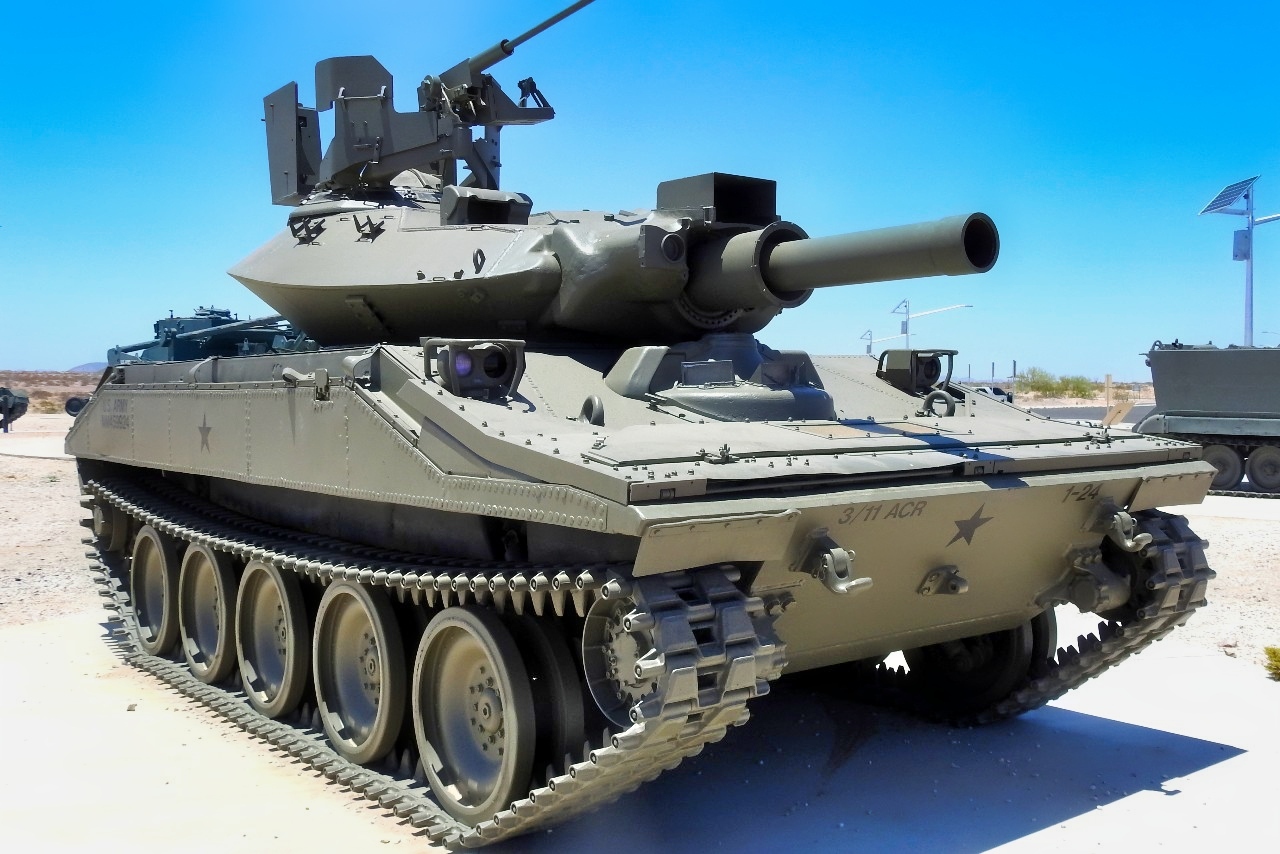One of the U.S. Army’s more forward-thinking Cold War-era armored platforms, the M551 Sheridan offered a unique mix of mobility and firepower.
Though promising, these attributes ultimately came at the cost of the vehicle’s armor. Other design flaws converged to reduce the Sheridan’s battlefield usefulness, and those flaws were never rectified.
Today, however, the Army has recognized the need for an infantry support platform that, like the M551, offers a mix of firepower and mobility – but unlike that tank, seemingly does not skimp on protective armor.
M551 Sheridan: A Flawed Light Tank
The M551 light tank entered service with the U.S. Army in the late 1960s. It was built to offer armored reconnaissance and airborne units a mobile, air-transportable armored platform. The Sheridan’s aluminum armoring kept its weight low.
At around 15 tons, the M551 could travel across many types of terrain, thanks to its respectable weight-to-power ratio.
The Sheridan’s main gun, the M81 gun launcher, was an enormous 150 mm in diameter. It could fire large explosive shells, as well as the MGM-51 Shillelagh guided missile, one of the early Cold War-era guided anti-tank missiles.
Though the M81’s dual-munition ability promised a way to hit a variety of targets, the design had several imperfections.
Given the Shillelagh missile’s large size, the M551 could only carry a limited number. The missile’s minimum engagement range was a wide 2,400 feet, and the Sheridan had to be relatively far away to engage targets with the missiles.
In contrast, the M81 gun’s high-explosive anti-tank (HEAT) rounds had a maximum range of just 2,000 feet, effectively leaving the light tank with a 400-foot-wide dead belt in which a target was effectively out of range.
Design and Shortcomings
Compared to the other armored vehicles with which it operated, the M551 was much more heavily armed. The Sheridan’s HEAT rounds proved potent against enemy fortifications and strengthened positions. Its anti-personnel munitions were powerful against groups of enemy soldiers. Compared to the M48A3, the Sheridan was faster and more nimble, with a reliable set of tracks that reportedly rarely, if ever, threw a track.
Despite these positive attributes, the Sheridan exhibited a number of fundamental problems and design flaws that fed concerns over the M551’s survivability.
The Sheridan “was far more vulnerable to mines and rocket propelled grenades (RPGs) than the M48A3 (additional armor was added to the tank’s floor for protection against mines),” The Army Historical Foundation explains.
“In some cases,” the AHF says, “enemy heavy machine gun rounds penetrated the Sheridan’s light aluminum armor. Compounding this problem was the highly combustible caseless main gun ammunition, which if hit, could lead to a catastrophic explosion. The main gun’s bore evacuator did not always work properly, leaving remnants of the casing in the breach, which sometimes blew back into the tank and created a serious fire hazard. Moisture sometimes caused the ammunition to swell, making it difficult to load.”
The Sheridan was not heavy enough to properly absorb the recoil caused by firing the M551’s main gun. “Some crews reported that the front end of the tank would literally lift off the ground when the gun fired, resulting in various components, such as the radio, coming loose,” the AHF explains.
Ultimately, the Sheridan proved unable to cope with Southeast Asia’s perpetually stifling clammy atmosphere. “Crews would often find droplets of water all round the turret, especially around the radio mount,” the AHF attests. “Engines would become clogged with vegetation and overheat. The crew compartment was cramped—coupled with the hot weather of Vietnam, crews became easily fatigued.”
After the war in Vietnam, the Army decided to retire the M551, and the program ended in the late 1970s. Senior leaders were cognizant of the platform’s flawed design and resultant operational shortcomings. Though the Army fielded several interim vehicles to fill some of the operational requirements the Sheridan had met, the Army only recently selected a more permanent replacement: the M10 Booker.
Back to the Future?
In what may seem like a return to form, the Army has now adopted the M10 Booker, but problems are already mounting.
Though often erroneously identified as a light tank, the Booker fills an entirely different role. Its job on the battlefield is not to engage in combat with main battle tanks, but to support infantry, using its 105-mm main gun to destroy fortified positions and take on gun systems and lightly armored vehicles.
This is an entirely different task from going up against larger main battle tanks. The M10 Booker is, in essence, an infantry support vehicle.
Postscript
One of the Sheridan’s greatest strengths, the off-road mobility enjoyed thanks to a favorable weight-to-power ratio, came at a significant cost in armor protection. Also cursed with notoriously unreliable ammunition, the M551’s utility on the battlefield was blunted.
But with the recent introduction of the Booker into service, the U.S. Army is making another foray into more heavily armed infantry support vehicles. At least, for the moment.
About the Author: Caleb Larson
Caleb Larson is an American multiformat journalist based in Berlin, Germany. His work covers the intersection of conflict and society, focusing on American foreign policy and European security. He has reported from Germany, Russia, and the United States. Most recently, he covered the war in Ukraine, reporting extensively on the war’s shifting battle lines from Donbas and writing on the war’s civilian and humanitarian toll. Previously, he worked as a Defense Reporter for POLITICO Europe. You can follow his latest work on X.

